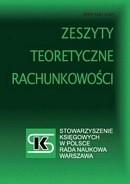Dokonania finansowe zespołów
a postrzegana wartość kapitału intelektualnego
na przykładzie jednostki sektora usług finansowych
Relationship between financial performance of teams and the perceived value
of intellectual capital – exemplified by unit delivering financial servic
Author(s): Andrzej PiosikSubject(s): Economy
Published by: Stowarzyszenie Księgowych w Polsce
Summary/Abstract: The purpose of the article is to describe the relationships between financial performance of teams of agents delivering financial & insurance services and perceived value of intellectual capital. In order to gauge the financial performance of teams we use a few variables: life insurance fee per agent per year, fulfilment of planned life insurance fee [%], commission on sales for new customers (or new products), total fee for financial services per year, total life insurance fee per year. The perceived value of intellectual capital is gauged using survey of 48 teams of agents in one corporation. The managers of the teams are asked 27 questions concerning intellectual capital: human, external and internal structure and organizational. Control variables are also taken into account: headcount of the team, average age of agents, age of a team, indicator of early laps (WWL) and agents’ retention rate. We found evidence that human capital is the most important element of intellectual capital for teams delivering financial services. The perceived value of the elements of teams’ human capital is correlated with their financial performance. The link between median values of elements of teams’ human capital and financial performance is even stronger. Financial performance is linked with the appraisal of analysis of changes in insurance law. The correlation between the perceived values of other structures of intellectual (including the median values of thereof) and financial performance is weak. However some estimates of the value of external structure and organization are linked with teams’ financial performance: the evaluation of agents’ cooperation with banks and organizations in order to acquire new customers, sharing the information and knowledge with other agents within the team and the evaluation of knowledge reporting and maintaining. The links between financial performance measures and the control variable are generally weak. However some financial measures are linked positively with headcount of a team. We also found evidence that financial performance is negatively linked with WWL. We constructed an econometric model for each financial measure describing the relationship between financial performance, perceived value of intellectual capital element (or elements) and control variables. For instance life insurance fee per agent per year is modelled as function of three variables: natural log of team’s headcount, average age of team and median value of perceived human capital. Percentage of fulfilment of planned life insurance fee per year is described as a function of natural log of teams’ headcount, WWL, median value of perceived human capital and one estimate of external structure (cooperation with banks and other organizations in order to acquire new customers).
Journal: Zeszyty Teoretyczne Rachunkowości
- Issue Year: 2009
- Issue No: 48
- Page Range: 125-144
- Page Count: 19
- Language: Polish

